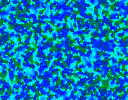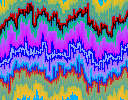Cellular automata are the simplest models of spatially distributed
processes. They consist of an array of cells, each of which is allowed
to be in one of a few
 states.
At the same time, each cell looks to its neighbors to see what states they
are in. Using this information each cell applies a simple rule to determine
what state it should change to. This basic step is repeated over the whole
array, again and again. Some of the patterns produced, by several simple
cellular automata, are shown on this page.
states.
At the same time, each cell looks to its neighbors to see what states they
are in. Using this information each cell applies a simple rule to determine
what state it should change to. This basic step is repeated over the whole
array, again and again. Some of the patterns produced, by several simple
cellular automata, are shown on this page.

Cellular automata were invented in the 1940's by the mathematicians
John von Neuman and Stanislaw Ulam, while they were working at the Los
Alamos National Laboratory in northern central New Mexico. The most famous
cellular automaton is the
"Game
Of Life"
invented by mathematician John
 Conway, in the 1960's. Despite the simplicity of the rules governing the
changes of state as the automaton moves from one generation to the next,
the evolution of such a system is complex indeed.
Conway, in the 1960's. Despite the simplicity of the rules governing the
changes of state as the automaton moves from one generation to the next,
the evolution of such a system is complex indeed.
For interactive cellular automata simuations, go to Prof. David Griffeath's
Java-based page
CAffeine
.
(The images on this page were produced by Prof. Griffeath and his students.)
A great collection of animated simulations is available at the
Live
Artificial Life Page
.
|